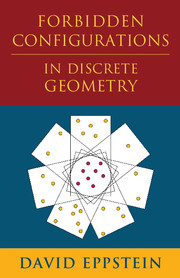Book contents
- Frontmatter
- Contents
- Acknowledgments
- 1 A Happy Ending
- 2 Overview
- 3 Configurations
- 4 Subconfigurations
- 5 Properties, Parameters, and Obstacles
- 6 Computing with Configurations
- 7 Complexity Theory
- 8 Collinearity
- 9 General Position
- 10 General-Position Partitions
- 11 Convexity
- 12 More on Convexity
- 13 Integer Realizations
- 14 The Stretched Geometry of Permutations
- 15 Configurations from Graphs
- 16 Universality
- 17 Stabbing
- 18 The Big Picture
- Bibliography
- Index
13 - Integer Realizations
Published online by Cambridge University Press: 04 May 2018
- Frontmatter
- Contents
- Acknowledgments
- 1 A Happy Ending
- 2 Overview
- 3 Configurations
- 4 Subconfigurations
- 5 Properties, Parameters, and Obstacles
- 6 Computing with Configurations
- 7 Complexity Theory
- 8 Collinearity
- 9 General Position
- 10 General-Position Partitions
- 11 Convexity
- 12 More on Convexity
- 13 Integer Realizations
- 14 The Stretched Geometry of Permutations
- 15 Configurations from Graphs
- 16 Universality
- 17 Stabbing
- 18 The Big Picture
- Bibliography
- Index
Summary
Every general-position configuration can be realized by points with integer coordinates. However, realizing a configuration that has three or more points in a line may require the use of noninteger coordinates. The existence of an integer-coordinate realization is a monotone property, as is the existence of a realization for which all distances are integers.
Definition 13.1
We define the property INTEGER-COORDINATES(S) to be true when S can be realized by points all of whose Cartesian coordinates are integers. We define the property INTEGER-COORDINATES(S) to be true when S can be realized by points all of whose pairwise Euclidean distances are integers.
Another way of defining integer-coordinates(S) is that it is the property of being a subconfiguration of grid(n) for some n. On the other hand, it is not known whether all grids can be realized with integer distances. Figure 13.1 shows an integer-distance realization of grid(2, 3).
Open Problem 13.2
Which grids can be realized with integer distances?
We could equivalently substitute the rational numbers for the integers. Any set of points whose coordinates or distances are rational can be scaled tomake them integers, without changing its order type. Klee and Wagon (1991) trace the history of the integer distance problem (in its equivalent formulation with rational numbers) to the seventh-century Indianmathematician Brahmagupta, who already asked about rational-distance realizations of POLYGON(4).
The Perles Configuration
The realizability of configurations using rational coordinates was considered by Micha Perles in the 1960s. Perles found an unrealizable configuration now called the Perles configuration, consisting of nine points at the corners and center of a regular pentagram (Figure 13.2).
The properties of this configuration depend on the projective transformations of the plane and on a number defined fromquadruples of collinear points called their cross-ratio. A projective transformation is a transformation of the plane that preserves collinearities among all of the (infinitely many) triples of points in the plane. The cross-ratio of four distinct points A, B, C, and D appearing in that order along a line is defined as
- Type
- Chapter
- Information
- Forbidden Configurations in Discrete Geometry , pp. 141 - 150Publisher: Cambridge University PressPrint publication year: 2018

